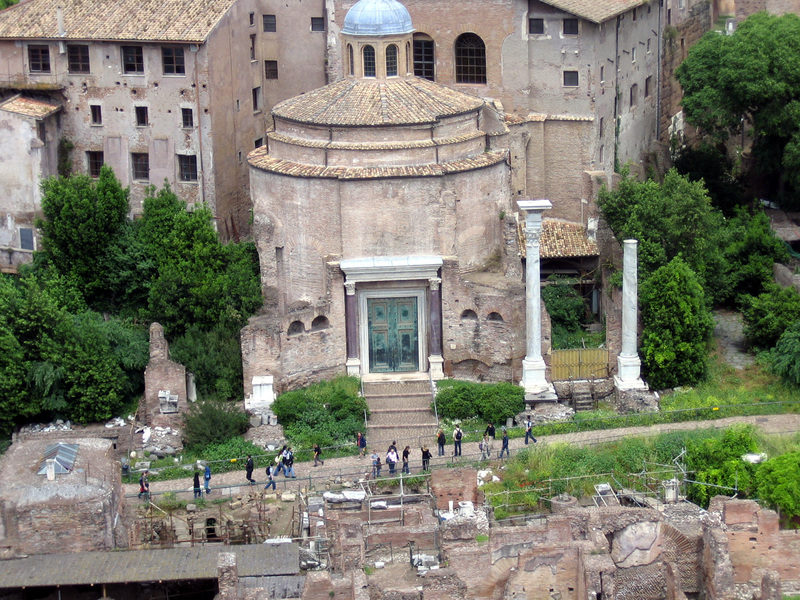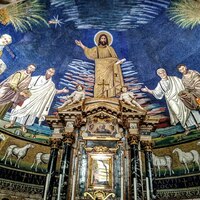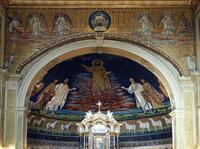Sts. Cosmas and Damian
Date:
526–30
Location or Findspot (Modern-Day Country):
Italy
Description:
A church dedicated to the third-century brothers and physician saints Cosmas and Damian was built in Rome in the 520s after the bishop of Rome, pope Felix IV (r. 526–30), obtained the property from Theoderic, the Ostrogothic ruler if Italy. It was located in the very heart of the classical capital, inserted into two ancient buildings and entered from the Roman Forum. The church had a second-century bronze door flanked by porphyry columns placed there by Emperor Constantine (d. 337). These were spolia, but the mosaic in the apse conch was a new, sixth-century addition.
In the apse, saints Peter and Paul introduce Cosmas and Damian (who hold crowns of martyrdom) to Christ, who stands before fiery clouds and gestures up toward a radiant phoenix, a symbol of resurrection, while holding a scroll. At the right edge is the military saint Theodore (the patron saint of Theoderic), also holding a crown; and at the left is a seventeenth-century reworking of Pope Felix, who paid for the mosaic and is shown offering a model of the church. Pope Felix is thus shown at the same level as the saints, and his offering is analogous to their martyrs' crowns. Below, a row of twelve sheep represents the apostles and the Christian flock more generally. Later renovations have obscured both the central Agnus Dei and the cities of Jerusalem and Bethlehem from which the sheep emerge. The mosaic is attributed to Pope Felix in the metrical Latin inscription at the base, which expresses the pope's hope to be "granted life in the highest heavens." This composition was the model for many later church apses in Rome.
The arch that frames the apse, which may be slightly later in date, depicts symbols of the Second Coming of Christ: the Hetoimasia (Rev. 5:1), seven lamp stands (Rev. 1:12), angels, and evangelist symbols. The twenty-four Elders (Rev. 4:4) who raised their crowns toward the Lamb of God on the prepared throne disappeared in the seventeenth-century rebuilding, but a few disembodied arms and crowns remain in the lower corners. The prepared throne closely resembles an altar, and seven candelabra were placed around the altar during the eucharistic liturgy in early medieval Rome.
In the apse, saints Peter and Paul introduce Cosmas and Damian (who hold crowns of martyrdom) to Christ, who stands before fiery clouds and gestures up toward a radiant phoenix, a symbol of resurrection, while holding a scroll. At the right edge is the military saint Theodore (the patron saint of Theoderic), also holding a crown; and at the left is a seventeenth-century reworking of Pope Felix, who paid for the mosaic and is shown offering a model of the church. Pope Felix is thus shown at the same level as the saints, and his offering is analogous to their martyrs' crowns. Below, a row of twelve sheep represents the apostles and the Christian flock more generally. Later renovations have obscured both the central Agnus Dei and the cities of Jerusalem and Bethlehem from which the sheep emerge. The mosaic is attributed to Pope Felix in the metrical Latin inscription at the base, which expresses the pope's hope to be "granted life in the highest heavens." This composition was the model for many later church apses in Rome.
The arch that frames the apse, which may be slightly later in date, depicts symbols of the Second Coming of Christ: the Hetoimasia (Rev. 5:1), seven lamp stands (Rev. 1:12), angels, and evangelist symbols. The twenty-four Elders (Rev. 4:4) who raised their crowns toward the Lamb of God on the prepared throne disappeared in the seventeenth-century rebuilding, but a few disembodied arms and crowns remain in the lower corners. The prepared throne closely resembles an altar, and seven candelabra were placed around the altar during the eucharistic liturgy in early medieval Rome.
Relevant Textbook Chapter(s):
3
Image Credits:
Wikimedia Commons; Linda Safran



